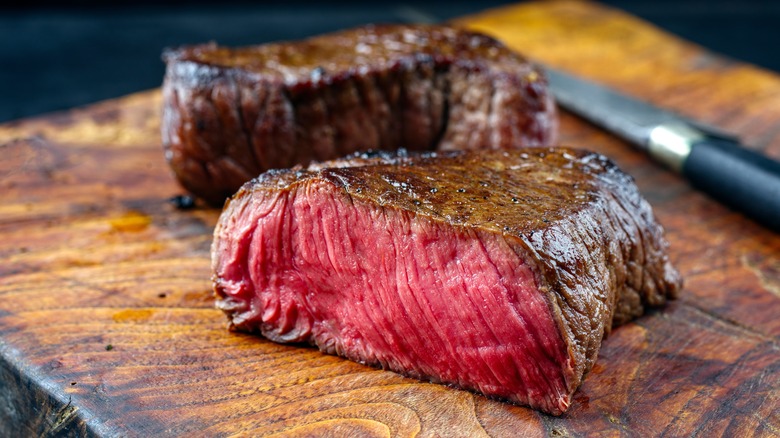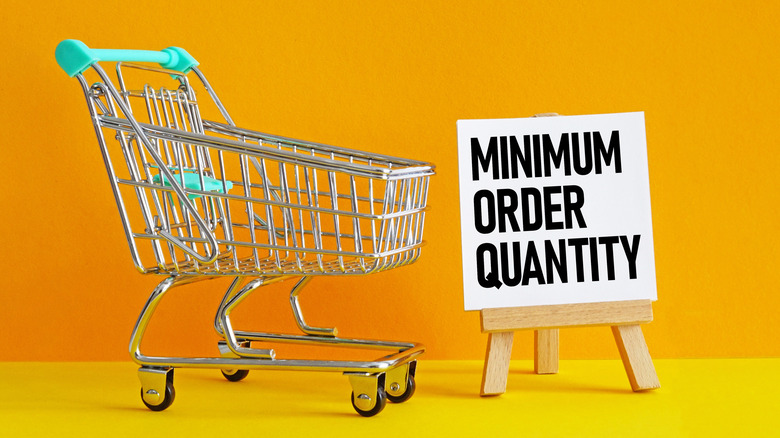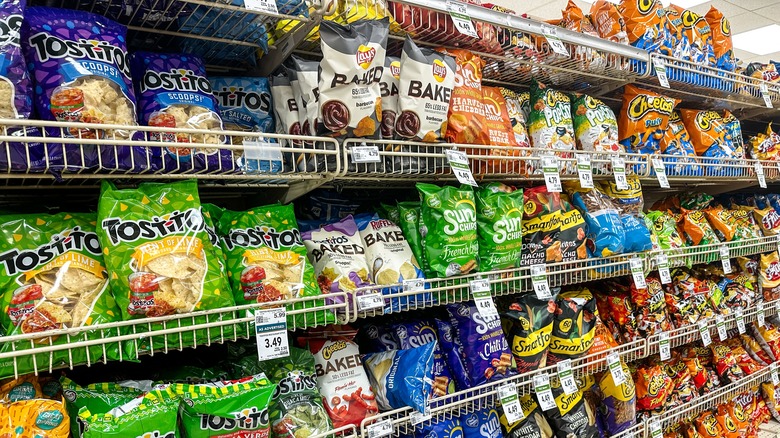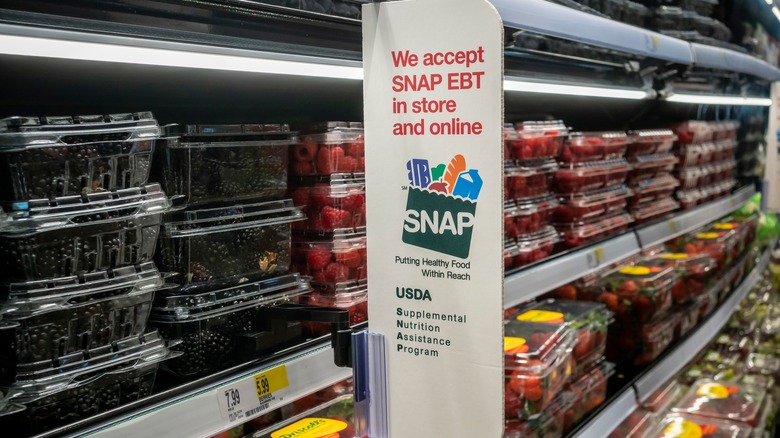12 Things To Avoid Doing When Ordering Groceries To Your Home
Once upon a time in a galaxy far, far away, grocery delivery was fairly limited to hot, cooked grocery deliveries of the pizza persuasion, and while plenty of companies have offered delivered throughout the years, the practice of having your groceries delivered did not truly kick up until the COVID-19 pandemic.
Still, despite the proliferation of grocery delivery services that have sprung up in the years since, plenty of people have either never tried grocery delivery or have not made the greatest use of those services. As such, they make plenty of rookie mistakes, like not checking their orders before hitting the "submit" button on their online carts, or not knowing how to choose a substitute for an item. However, with a bit of tutoring, these and other issues are easily remedied. Here is what you need to know to really take advantage of all the benefits of grocery delivery.
Ordering whole avocados if you need them right now
Many bargain shoppers pass by the pre-packaged avocado in the grocery store deli and go straight to the produce aisle when they need fresh avocados for a simple guacamole recipe. However, when you order your groceries for delivery, the kind of avocados you get is a crap shoot. They may be just right. They may be hard as a boulder. The trouble is you don't know which kind you'll get until your grocery delivery arrives. This is all fine and well, unless you're making something like a dip for a party you're having tonight.
That's why it pays to be savvy about the avocados you order for delivery. If you need avocados right away, like for a dip, then order at least a tub of already-prepped avocado pulp from the deli. Doing so won't give you sliced avocados to top a classic eggs Benedict recipe, but it will allow you to whip up some guacamole or add a dollop of the green stuff to food. In other words, you'll still get the flavor of the avocados and the substance of the fruit for the recipes, even if you're not getting that via whole or sliced avocados. And it doesn't mean you can't order a few whole fruits, too, if you'll need them for recipes later in the week. Just make sure that you have avocados you can use today if you need them right now.
Never choosing a specific substitute for an item
One of the advantages of shopping in person is that you can see if an item you want is in stock and respond accordingly if it's not, usually by getting something else in its place. When you get your groceries delivered, the personal shoppers are trained to find a substitute. The problem is you may not like the substitution they pick. Fortunately, online grocery shoppers can choose the substitutions they want ahead of time, taking the decision out of the hands of the professional shopper and putting it into the hands of the consumer. Some online retailers even give customers the chance to opt out of an item altogether if a viable substitution isn't available.
Giving shoppers this choice has a significant impact on their grocery haul. Consider the person who might be allergic to a certain food, like beef. That person orders ground bison instead of ground beef when ordering groceries. If the store doesn't carry bison, the shopper may assume that beef is a viable substitute because bison is a red meat like beef. The underlying assumption here is that the customer ordered bison because it's a red meat instead of considering the possibility of a food allergy. If you're the customer in a case like this, stating a substitution is critical so that you don't get something you can't eat.
Not waiting to order when you can reach the order minimum
For most grocery delivery companies, free delivery is a thing — but only if certain conditions are met, and usually those conditions require the customer to hit a certain dollar amount, usually between $30 and $35. This is the case with Walmart, for example. Some of them, like Hungry Root, require as much as a $65-minimum order to get free delivery. If you don't order the minimum, you can still get your groceries delivered. However, there's typically a charge of between $5 and $10 on average. Other companies have no order minimum. Instead, they charge a fee for each delivery. And some companies charge a delivery fee and require a minimum order. Hive is a good example of this. Customers must order $25 worth of product to even get delivery and will still get charged a $6 delivery fee if the under is under $50.
The solution for this is the same in most cases. Don't order less than the required minimum. If the company charges a delivery fee every time no matter what, you'll still save money if you wait until your order is larger. For example, say the company charges $5.95 for each delivery and will charge that fee whether you order two separate $35 order or one $70 that's a combo of the two separate. You'll get the same amount of groceries by batching the orders into one big order instead of two small ones, but you won't get charged the second delivery fee, however, which saves you money.
Forgetting to shop around for a service
If you're considering a grocery delivery service, it pays to shop around for a service before finally settling on one. There are the usual suspects, of course, with Walmart and Instacart leading the charge. However, myriad grocery delivery services exist, each offering slightly different benefits. As far as general delivery is concerned, Instacart, Walmart, and Amazon Fresh get groceries to your door same day. Because of how big these vendors are, they offer potential customers an enormous selection. With Instacart, in particular, you have access to lots of major retailers – Albertson's, Kroger, Costco, and Eataly, which gives you great variety.
However, there are also specialty grocery delivery outfits, like Misfits Market, which sells off-sized, damaged, but still edible, and overstocked fruits, vegetables, and more; Fresh Direct, which is regional in the Northeast; and HungryRoot, which is a mashup of grocery and meal delivery. Amazon is another option to include, and it is especially good when you want to order something in bulk, like pasta or paper products. In light of all of this, it's worth looking at all of them before settling on one. It's also the case that sometimes it's better to order from more than one delivery service so that you can get complete coverage. For example, you may do your regular grocery ordering through Walmart, get something in bulk from Amazon, and finally, turn to a specialty retailer, like Misfits Market to get some hard-to-find items, like blood oranges or Italian pasta direct from Italy.
Not considering the store brand
One of the big advantages of shopping in person is that you get to spot bargains with your own eyes. You know where the store keeps the day-old bread rack or the fruits and veggies that are nearly past their prime. When you shop for groceries for delivery, you'll miss many of these obvious savings. However, that doesn't mean there aren't good deals to be had, the easiest of which to find is often hidden behind the name of the store's brand.
When you opt for the store's brand instead of a national brand, you often save a good chunk of change when you buy the same or similar products. For example, one of the Walmart's store brands is Great Value. If you eat pancake mix, you can buy the Great Value brand, which costs $1.88 for 32 ounces (as of this writing). Or you can purchase the Pearl Milling Company brand for $3.28 for the same amount of mix. Here you get the same amount of product for less money if you go with the store's brand rather than the "big" brand.
Online stores post the price, the ounces, and other information about the product. Compare the particulars behind each brand's offering to get the best price. Finally, don't just check the price on the items. Check the weight, too. The store brand may cost you more, but the package might also have more product in it, which saves you money.
Neglecting to take advantage of the service on vacation
If you're on vacation and living in a rental house with a kitchen for the duration of your break, you're probably planning on cooking your meals. However, shopping for groceries may not have the same appeal while you're on vacation. After all, in the worst case scenarios, it involves cranky people pushing grocery carts with wobbly wheels and even wobblier temperaments — and often right after work when they're really feeling cranky.
Fortunately, if you have a grocery delivery service membership, you can get groceries delivered to where you are. For most grocery delivery services, like Instacart or Walmart, you just need to temporarily change the delivery address. If you're really savvy about it, you'll order the groceries before you get into your car to leave on your trip and time the delivery so that it comes after you've arrived. No more traveling with sacks and sacks of groceries. Ordering food this way ensures that you get what you need when you need it. And if you run out of items while you're still away from home, you can just order more of what you need and have it delivered like you did with the rest of the stuff.
Being careless about perishables
Perishables, like ice cream, fresh fruits and vegetables, and bread from the deli, don't have a long shelf life when they're left out on your front porch — especially if it's a scorching summer day. They'll melt, rot, and get hard and crumbly in short order unless you bring them inside once they're delivered from the grocery store. The problem is you may not be home when the delivery comes, pretty much guaranteeing that your perishables will go bad unless you arrive just a few minutes shortly after your groceries do.
However, you're not completely powerless. Many grocery delivery services allow you to set the time for delivery. The expedited delivery options range anywhere from within the hour to up to three hours, or if you're in no hurry, anytime. Taking advantage of these options means that you're more likely to be home when the groceries arrive. Depending on the grocery delivery service you're using, you will pay for these express times. Take Walmart, for example. If you want your groceries delivered within the hour, it'll cost you $10. Within three hours sets you back around $5. Non-expedited service has no extra charges involved. As for other services, like Misfits Market, they have more general delivery times each week. However, they do pack the groceries in ice to ensure that they stay fresh in transport. Basically, if you want to avoid decimated groceries, you'll need to take advantage of express or on-ice delivery and good planning strategies. This ensures that you're more likely to be home just in time to take in that ice cream.
Disregarding age requirements
In some states and with some grocery delivery services, you can't order certain items unless you're either 18 or 21, (depending on what you're ordering), and while yes, this does apply to alcohol, it can also apply to items like cough medicine. In one case, you'll be adhering to the state's liquor laws. In the other case, the ID issue comes down to ordering certain cold medicines that can be used to make more nefarious drugs, like methamphetamines. And it's worth noting that items containing pseudoephedrine and dextromethorphan can't be ordered for delivery at all. You have to go to the store to pick those items up.
When you do order age-restricted items, you'll be expected to follow a specific protocol, similar to when you buy those items in the store. The rules will depend on the state you're in since that's where the rules originate. However, essentially, you'll need to be prepared to agree to certain terms and conditions upon checkout. Once the delivery person gets to your door, you'll have a few more hoops to jump through — namely, you'll be expected to show your ID and to sign for the items in question, so be prepared.
Avoiding a closer look at the sizes
Shrinkflation is a thing. You've probably noticed it when you've taken a trip down the grocery aisles. Your party-sized bag of tortilla chips looks like the party's already half over before you have even opened the bag. It won't be nearly enough to properly dip your favorite pico de gallo recipe in. Your 10-pack of burritos now only contains eight wrapped snacks. Loaves of bread look tiny, like mini loaves instead of sandwich-sized. The problem is easily spotted when you're in the grocery store. It's not so easily seen when you're shopping online. This can lead to you getting much less of an item than you were expecting.
Since you're not seeing the item in person, you'll need to employ some other methods to determine how much product you're going to get in a package. Looking at the photo helps, but it's only the first line of defense. Often the items in question aren't as big as they look. Tortilla chips bags are a good example of this. They'll be displayed side by side on the page, and the 13-ounce bag will look as big as the 17- and 24-ounce bags. In light of that, it helps to look at the number of ounces in a package. And if the items have a specific count, like the burritos, check to see how many pieces come in each package, too.
Not being mindful of the correct way to use SNAP/ EBT
SNAP, or Supplemental Nutrition Assistance Program, gives people access to healthy food in cases where their personal budgets might be lacking. Usually, the program funds are distributed through an Electronic Benefit Transfer, or EBT, card, which the consumer uses as a payment method when checking out at the grocery store. And what some may not know is that, as a result of the 2014 Farm Bill, it's possible to use an EBT card to pay for groceries online to be picked up or delivered to a customer's door.
However, there are some restrictions to know about. The program pays for the actual groceries, but it does not cover the costs of online fees nor delivery charges. The in-store restrictions as to what food an EBT cardholder can purchase also still apply. So items like hot food from the deli, alcohol, and pet food are off limits, or more accurately stated, can be purchased online but not paid for with funds from the EBT card. A number of online retailers accept EBT payments. Those include Walmart, Aldi, Albertson's, Amazon's Grocery and Gourmet Food section, and Fred Meyer/ Kroger, to name but a few.
Leaving savings on the table
You don't have to be a super couponer to understand the value of them. Saving $0.50 here and $1.50 there really adds up over the course of time. There are online rebates and coupons to be found and cash-earnings programs to be had so that online shopping won't cost you more than it needs to. Some of them are brand specific, like Walmart's Cash Earnings program. Others come via grocery and discount apps, like Ibotta. There are also promo codes that stores offer that allow them to partner with other companies to get the word out about the savings. These sometimes show up in sponsored content on sites like USA Today. Occasionally, you'll also see offers in company newsletters or online flyers. Finally, you may see a product with a savings banner on the sales page. That offers the same kind of on-the-spot savings that banner sales in the stores do, so take advantage of them.
Taking advantage of these savings can be pretty simple. You may just need to add a coupon code to your online shopping cart before you completely check out. For other programs, like Ibotta, you'll receive money back after your purchase. Finally, it's worth noting that not going into the actual store saves you cash, too, because you won't see all those impulse items like candy bars at the checkout line. That saves money, too.
Not double-checking your order
Even with the best intentions and the most-trained people, you're going to end up with mistakes on your grocery delivery order on occasion. Missing an item on your order runs you the risk of having to either make a separate order and be slapped with a $6-and-some-change delivery fee as a result of that. Or you'll have to make a run to the store yourself, if it's an item you can't live without. It's definitely less time-consuming and annoying to get the order right the first time. For that to happen, you should double-check your order, not just before you submit your shopping cart, but also when your grocery order arrives at your house.
If you wind up missing items you ordered, or you get something completely wrong, like receiving cucumbers instead of the zucchinis you ordered, not to worry. You do have some recourse if you end up with a disappointing grocery delivery. Most online retailers, like Instacart, have features that allow you to report missing items and get a credit for it. Once you've figured out that you're missing an item, report it via your online account immediately to get credit for it. And while mistakes are annoying, there is at least one benefit. If you received the wrong item, you get to keep it, even if you're given a credit for the mistake.












